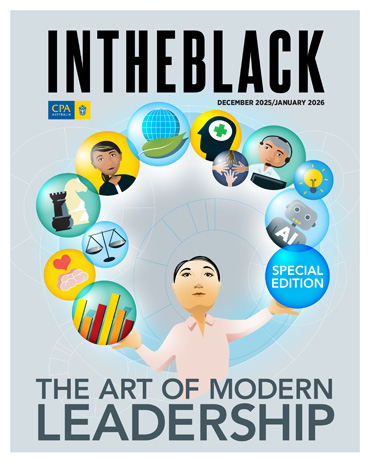Loading component...
At a glance
- While government policy may help to kickstart SME uptake of AI, many are asking how they should integrate it.
- SMEs often face additional barriers, such as integration with existing technologies and high implementation costs.
- Conducting an audit of the AI tools already used within a business, or those available in current software packages, is a good place to start.
It has been less than three years since the generative artificial intelligence (gen AI) tool ChatGPT burst onto the scene, casting a bright spotlight on the broad capabilities of AI systems. Data from CPA Australia’s Business Technology Report 2024 shows 69 per cent of respondents state that their organisation used AI that year, up from 55 per cent in 2023.
While much of the conversation around AI adoption has focused on “the big end of town”, smart tech for SMEs is now on the policy agenda for governments across the Asia-Pacific.
In Australia, for example, the federal government plans to spend A$17 million on four organisations that will assist small- and medium-sized businesses to adopt artificial intelligence as part of its AI Adopt Program. This will provide businesses access to AI expertise and provide them with free training to help staff develop skills to effectively manage AI.
In Singapore, up to 50 per cent of SMEs tech expenses, including pre-approved AI tools, will be subsidised by the government, as a part Singapore’s digitisation plans outlined in the Digital Enterprise Blueprint. Building on this, the Singapore Government announced in its 2025 budget that it will set aside up to S$150 million for a new Enterprise Compute Initiative.
Under this initiative, eligible enterprises will be partnered with major cloud-service providers to access AI tools and computing power, as well as expert consultancy services.
There is growing interest in AI in Singapore, with 22 per cent of SMEs noting that it was their biggest technology investment in 2024, up from 15 per cent in 2023.
While government policy may help to kickstart SMEs’ uptake of AI, many are still asking how they should integrate these tools into their operations seamlessly and securely.
Grow with AI
The potential power of AI is no longer in question. While the “human element” of accounting remains as vital as ever, AI-powered systems and data analytics enable practitioners to interpret huge amounts of data in a matter of seconds, identifying trends, optimising resource allocation and responding swiftly to market changes.
Results of CPA Australia’s report show tech uptake creates a competitive advantage among businesses. For example, 94 per cent of businesses that used digital payment technologies experienced increased profit in the preceding 12 months. Meanwhile, only 5 per cent of businesses that did not undertake any technology initiatives reported similar gains.
The survey results also reveal that profitable businesses are more likely to invest in technology upgrades, modernise their systems and build tech knowledge through upskilling and reskilling initiatives.

However, while most businesses have adopted AI to some extent, only 10 per cent report significant integration into their operations. This indicates huge untapped potential for better-leveraging AI across business operations.
“The level of businesses that said they are adopting AI is up from the previous survey but, for most businesses, it’s not a tool that they use daily,” says Gavan Ord, business investment and international policy lead, policy and advocacy, CPA Australia.
Of the businesses using AI, Ord says the benefits far outweigh the drawbacks.
"Choosing the right tech for a business is really about remembering what problem they’re trying to solve. It’s easy to lose focus on the outcome and become distracted by the marketing ploy."
“In terms of the negative impacts, 9 per cent had trouble integrating AI with their existing technologies, 8 per cent said it raised data and privacy concerns and 6 per cent said it raised ethical concerns,” he says. “But 27 per cent said it improved efficiency, 24 per cent said it improved productivity and 22 per cent said it improved decision making.”
What's holding SMEs back?
AI adoption comes with challenges for organisations of all sizes. A recent survey of SMEs by the Human Technology Institute at University of Technology Sydney (UTS) with elevenM Consulting, shows that knowledge gaps and costs are major challenges.

“We found that 34 per cent of responding SMEs said their understanding and knowledge of AI was a barrier to implementing it in their business,” says Melanie Marks, director at elevenM, which is leading the delivery of Safe AI Adoption Model (SAAM), one of the Australian Government’s AI Adopt Centres.
“These concerns focused around not knowing the full benefits or how to get the most out of AI and not understanding the risks associated with adopting AI.”
The survey also shows that 20 per cent of respondents cite financial barriers, such as subscription fees, pricing models and licensing fees, as a barrier to AI integration.
5 common finance problems AI can tackle
How to be "AI ready"
What do you need to have in place to be “AI ready” and implement it safely? Marks says this depends on what you plan to use it for.
“AI takes so many different forms,” she says. “We could be looking at something as simple as using ChatGPT, which doesn’t require a lot of readiness. In contrast, an AI product that manages financials for a business could require data impact assessments, data firewalls or contract reviews.”
When considering significant AI investments, creating a business technology roadmap can help to guide safe and efficient AI adoption. It should include a timeline that features goals, assigns responsibilities and determines key milestones, as well as project phases and desired outcomes.
When creating a roadmap, resources provided by tools like SAAM will draw from best-practice AI safety frameworks, including the Australian Voluntary AI Safety Standard, Australia’s AI Ethics Principles and other global standards.
While many of these frameworks are better suited for adoption by larger and more mature organisations, Marks says SAAM will be tuned to the specific needs and requirements of SMEs.
“With SAAM, we’re seeking to create resources for SMEs to help them feel safe in their adoption of AI tools, so they understand the risks and they know how to make informed choices,” says Marks. “We have a two-year program to roll out these resources.”
Employee engagement is also critical to the success of any transformation project.
“During our survey, we found more than two-thirds of employees who were surveyed felt that AI had a positive impact on SME workplaces,” says Marks. “Of those same respondents, 70 per cent stated that they came to use AI at work because they were encouraged to do so by their employers.
This shows that employees are generally pretty accepting of AI adoption, at least in small-to-medium businesses.”
Cutting through the hype

Before investing in sophisticated tech tools, businesses should conduct an audit of the AI tools being used in the business [see breakout] according to Alan FitzGerald, founder of software advisory business Practice Connections. These may include Microsoft Office 365, which includes AI-powered features.
For example, Excel's AI-powered functions like “Ideas” and “Insert Data from Picture” enable automated data analysis and visualisation.
“A misunderstanding people have of AI is that it’s something you have to buy or have to spend huge amounts of time learning about,” says FitzGerald. “The reality is that many of the systems that you already have in place in your business are using AI in some shape or form, and that’s the great opportunity.”
"27 per cent [of SMEs] said [AI] improved efficiency, 24 per cent said it improved productivity and 22 per cent said it improved decision making."
Marks suggests starting with a problem the business is looking to solve and then looking for the right tech solution.
“When we asked SMEs about the inhibitors to AI adoption, there was a quote from someone who said one of their barriers was ‘the overhyped nature of AI’,” says Marks. “They said it was ‘probabilistic, not deterministic’.
“This shows there is some difficulty for SMEs in identifying the right AI products for their business,” she adds.
“Choosing the right tech for a business is really about remembering what problem they’re trying to solve. It’s easy to lose focus on the outcome and become distracted by the marketing ploy.”
Manage the risks
To fully capitalise on AI’s potential, businesses of all sizes are encouraged to invest in upskilling employees and exploring partnerships with AI vendors for tailored solutions.
However, Marks also encourages SMEs to not only consider the benefits of AI, but also how to manage the risks it may present.
“If you are out looking at new tools, or want to rely on a product that doesn’t come from a well-known provider like Microsoft, how do you know what checks and balances exist? How safe and secure is your data? What’s going to go from your own search inquiries into a data set that can present issues for intellectual property and commercial sensitivity, trade secrets and reliability?”
Marks suggests starting with trusted vendors.
“Once you’re comfortable that a vendor is trustworthy because of their data handling practices, then that’s a good place to start with the additional tools,” she says. “Ask questions like, ‘How does the tool collect, use and disclose the information that you’re putting in?’ The other thing is that [AI] is currently quite immature, so how do you know that you can rely on what you’re finding and using?”
FitzGerald says skills like professional skepticism are vital when using AI tools safely. In other words, don’t assume it knows better.
“The opportunity is not to fight against the machine, but to make the machine work for you.”
Are you already using AI?

If any of these tools are being used, AI has already entered the workplace.
Virtual assistants: Tools like Siri, Alexa and Google Assistant are powered by AI algorithms that continually adapt and refine their responses based on user patterns and habits.
Smartphone predictions and auto-responses: These AI-powered tools learn from linguistic patterns, speeding up communication and reducing typos.
Cloud-based accounting software: Software such as Xero and MYOB use AI-enabled tools to perform simple tasks like reading electronic or hard-copy invoices and receipts to capture the key data and enter it into the accounting ledger. Just Ask Xero (JAX) uses generative AI to help users complete tasks such as generating invoices or editing quotes.
Microsoft 365: This suite of products comes with an AI-powered productivity tool called Copilot. It provides content relevant to work tasks such as drafting, summarising and answering questions within the Microsoft 365 app. Excel also uses Microsoft 365 Copilot to speed up certain spreadsheet tasks such as adding columns and formulas, formatting tables and inferring insights about given data.
Email spam filters: These tools use AI to scan incoming emails to identify and filter-out spam messages.

